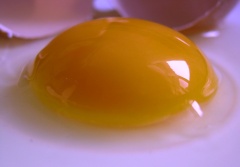Egg Yolk
| Infobox on Egg Yolk | |
|---|---|
| Example of Egg Yolk |  |
| Facts | |
| Origin | - |
| Stowage factor (in m3/t) | - |
| Humidity / moisture | - |
| Ventilation | - |
| Risk factors | See text |
Egg Yolk
Description
An egg yolk is a part of an egg which feeds the developing embryo. The egg yolk is suspended in the egg white (known alternatively as albumen or glair/glaire) by one or two spiral bands of tissue called the chalazae. Prior to fertilization, the yolk together with the germinal disc is a single cell, one of the few single cells that can be seen by the naked eye.
As a food, yolks are a major source of vitamins and minerals. They contain all of the egg's fat and cholesterol, and about one-half of the protein. If left intact while cooking fried eggs, the yellow yolk surrounded by a flat blob of whites creates the distinctive sunny-side up form of the food. Mixing the two components together before frying results in the pale yellow form found in omelettes and scrambled eggs.
Application
- It is sometimes separated from the egg whites and used in cooking (for mayonnaise, custard, hollandaise sauce, crème brûlée, avgolemono, and ovos moles).
- It is used in painting as a component of traditional egg-tempera.
- It is used in the production of egg-yolk agar plate medium, useful in testing for the presence of Clostridium perfringens.
- Egg yolks also contains an antibody called antiglobulin (IgY). The antibody transfers from the laying hen to the egg yolk by passive immunity to protect both embryo and hatchling from microorganism invasion.
- Egg yolk can be used to make liqueurs such as Advocaat or eggnog.
- Egg yolks are used to extract egg oil which has various cosmetic, nutritional and medicinal uses.
- The developing embryo inside the egg uses the yolk as sustenance.
Shipment / Storage / Risk factors
Shipped in tins inside cases. It is manufactured in dried and frozen form. When frozen has to be carried in refrigerated spaces, with the same problems as frozen eggs. If not refrigerated should be stowed in a cool place. Will take taint from odorous cargoes.











